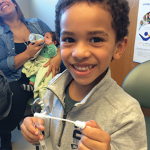- Make an effort to get to know families of children with rheumatic diseases to “understand where they’re coming from and to empower and educate them” to partner with investigators as they develop shared study goals. Parents and pediatric patients should be viewed as full partners in studies, not as subjects of research;
- Explain terms or acronyms that may seem like the “alphabet soup of doctor-speak” to parents. STOP-JIA included plain-language health literacy policy developed by PARTNERS, a pediatric rheumatology patient research network, so “everyone was speaking the same language,” and created a newsletter formatted by a teenage patient that provided updates on the study and explained medical terminology; and
- Include parents and pediatric patients in the development of study survey or focus group questions and recruitment tools; they should be involved in conference calls and meetings related to the study, so they don’t become siloed and marginalized. Patients and their parents have much to contribute to meaningful research.
Patient Engagement: Investigator’s Perspective
When investigators include parents and pediatric patients on the research team from the inception of the study, “it increases the relevance of the results for implementation into clinical care,” said Dr. Morgan, who is the clinical lead/principal investigator for PR-COIN. Parents are on committees that review grant applications and help investigators determine which outcomes are of most interest to patients, she said.
Little research has been conducted on why patient engagement benefits research outcomes, but a 2014 systematic review of 142 studies found that although patient engagement in studies is feasible and increases the relevance of findings, a danger of patients being no more than tokens in the process exists, and involvement in research can be costly for parents and patients when it comes to time commitment, travel and absence from school or work.3 Mistrust of academia, scientists or medical research by patients or their parents are potential barriers to engagement. The study also found the most common time for patient involvement is at the beginning, when they are consulted to help set the agenda and develop protocols.
Patient engagement is required for grants to be funded by PCORI and other groups, and strong ethical reasons exist for involving them, said Dr. Morgan.
“If patients are going to be studied in research, they should have a say in the conduct of the study as well,” she said. “When you include patients on your research team, they are able to provide input on the study materials and recruitment tools, to attract more patients to participate. If you have more enrollment and patients stay involved longer, it will improve the relevance of your study. It will be a higher impact study. If you want people to adopt your findings into clinical care, you better start with outcomes that really make a difference for people.”
Dr. Morgan suggested three study phases with good opportunities for patient and parent engagement:


